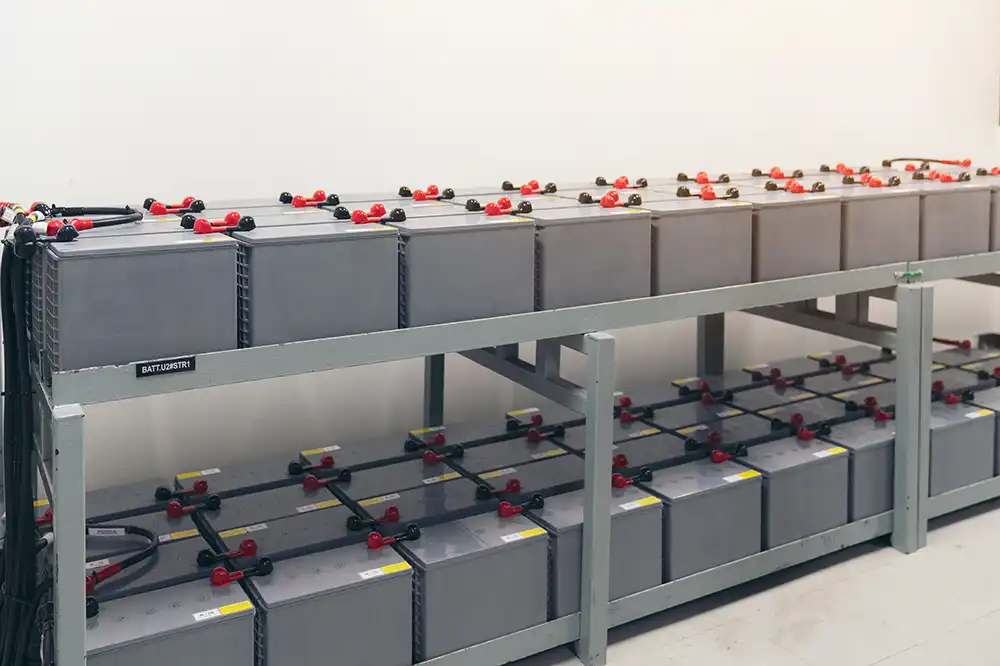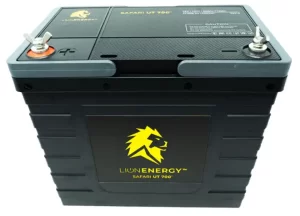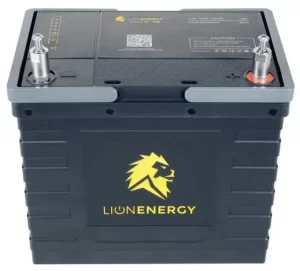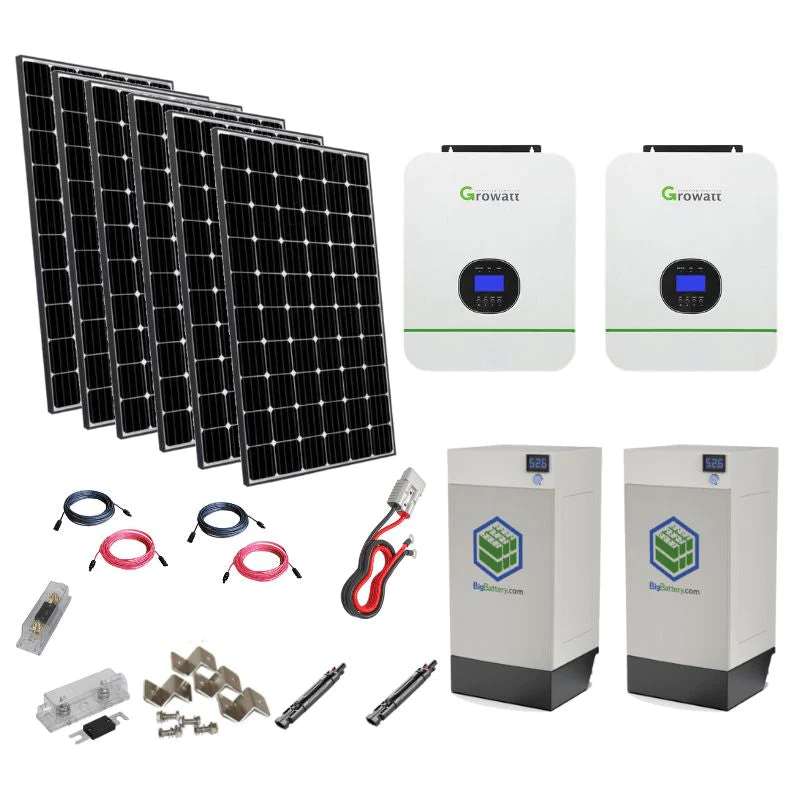The Best Batteries for Solar Tiny Homes
Most batteries on the market can be divided into two main categories, lead-acid and lithium-ion. Lithium-ion batteries are the best choice for tiny homes for four main reasons. They have longer usable lifespans, they have greater usable capacity, they can provide adequate power for high drain appliances, and they don’t emit toxic gasses. With lithium-ion batteries being superior to lead-acid in every measurable way, the only reason to consider lead-acid is if your upfront budget is very tight.
Our Top Picks
When planning your own solar power system, a great first option is to go with a kit of matching components. If you are interested in this option, check out our article on wind and solar options for tiny homes. If you are confident in your abilities to match components and design your own system, please proceed with caution.
When it comes to storing solar energy, we are big believers in Lion Energy here at Brilliant Tiny Homes. Their batteries are built like tanks and their onboard battery monitoring system (BMS) sets a benchmark for the industry. The only reason I would ever choose a different solar power system battery is if these were out of stock and back ordered for a year!
Best all around: Lion Energy – UT 700 – Lithium-ion Battery – 12V / 56Ah / 716Wh Deep Cycle Lithium Solar Power Battery
Best for partial or infrequent systems: Lion Energy Safari UT 250 Lithium Ion Battery
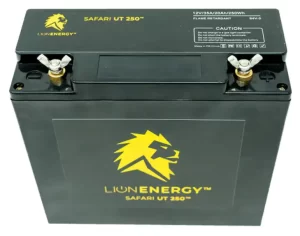
Best for large arrays: Lion Energy Safari UT 1300 Lithium Ion Solar Battery | 105Ah Solar Battery [LiFePO4]
Lead-Acid Batteries
Lead-acid batteries are a type of rechargeable battery first invented in 1859. Lead-acid batteries store energy by a reversible chemical reaction. Basically, when a battery is discharged, the sulfuric acid in the electrolyte is being depleted so that the electrolyte more closely resembles water. At the same time, sulfate from the acid is coating the plates and reducing the surface area over which the chemical reaction can take place. Charging reverses the process by driving the sulfate back into the acid.
The electrolyte solution (sulfuric acid and water) found in lead-acid batteries contains charged ions of sulfate and hydrogen. The sulfate ions are negatively charged, and the hydrogen ions have a positive charge. When connected to a load, a chemical reaction takes place in the battery. The sulfate ions move to the negative plates in the battery and give up their negative charge. The remaining sulfate combines with the active material on the plates to form lead sulfate. This reduces the strength of the electrolyte, and the sulfate on the plates acts as an electrical insulator. The excess electrons flow out the negative side of the battery, through the electrical device, and back to the positive side of the battery. At the positive battery terminal, the electrons rush back in and are accepted by the positive plates. The oxygen in the active material (lead dioxide) reacts with the hydrogen ions to form water, and the lead reacts with the sulfuric acid to form lead sulfate.
The ions moving around in the electrolyte are what create the current flow, but as the cell becomes discharged, the number of ions in the electrolyte decreases the area of active material available to accept them also decreases because it’s becoming coated with sulfate. Remember, the chemical reaction takes place in the pores on the active material that’s bonded to the plates.
Lead-acid batteries come in several varieties such as flooded, AGM, and gel-filled. Flooded lead-acid batteries require water levels to be topped off periodically. They also vent gasses and can leak liquid if not stored upright. Flooded lead-acid batteries should never be used indoors. Absorbent Glass Mat (AGM) and gel-filled batteries are sealed to prevent harmful off-gassing to a great extent and are considered safe to use indoors despite the potential for some minimal off-gassing. These more modern styles of lead-acid batteries address some of the safety concerns with flooded batteries, but cost more and still suffer the limited performance inherent in all lead-acid battery formats.
Lithium-Ion Batteries
The electrochemical process for lithium-ion batteries was first discovered in the 1970’s. When a lithium-ion battery is connected to a load, lithium atoms in the anode are ionized and separated from their electrons. The lithium ions move from the anode and pass through the electrolyte until they reach the cathode, where they recombine with their electrons and electrically neutralize. The lithium ions are small enough to be able to move through a micro-permeable separator between the anode and cathode. In part because of lithium’s small size (third only to hydrogen and helium), Li-ion batteries tend to have a very high voltage and charge storage per unit mass and unit volume when compared with low power density alternatives like lead-acid.
Li-ion batteries can use a number of different materials as electrodes. The most common combination is that of lithium cobalt oxide (cathode) and graphite (anode), which is most commonly found in portable electronic devices such as cell phones and laptops. Other cathode materials include lithium manganese oxide (used in hybrid electric and electric automobiles) and lithium iron phosphate. Li-ion batteries typically use ether (a class of organic compounds) as an electrolyte.
Lithium batteries built for storing solar energy contain internal circuits to shut down the battery in case of a short or surge. They are also completely free from toxic gasses and can (and should) be stored inside.
Lithium-Ion Vs. Lead-Acid
Capacity
Lithium-ion batteries offer much more power storage per volume than lead-acid batteries. In fact, one lithium-ion battery can store up to four times as much power as a similarly sized lead-acid battery.
Longevity
Battery life is measured in cycles of charge and discharge. But, when we discharge a battery, we don’t drain it completely. Lead-acid batteries can only be discharged to about 50% without risk of damage to the battery. Lithium-ion batteries on the other hand, can be safely discharged up to 85%. So a lithium-ion battery will inherently last 35% longer than a lead-acid battery with the same cycle life.
High-drain
Being a low-density power storage solution, lead-acid batteries simply cannot handle high-drain loads. A grossly disproportionate amount of lead-acid batteries are required for tasks like heating and boiling water when compared with energy-dense lithium-ion batteries.
Cost
At first glance, this seems like it would be the one category that lead-acid batteries would win easily. Lead-acid batteries of all varieties are cheaper than lithium-ion batteries across the board. However, when the cost of four times as many batteries is considered, lead-acid batteries lose their cost advantage. This is further compounded in the long-term when replacement costs must be considered.
Conclusion
Despite being cheaper on a per unit basis, lead-acid batteries are objectively a worse value and are an antiquated technology for uses such as solar energy storage.
Go forth with your knowledge and dare to live tiny!

